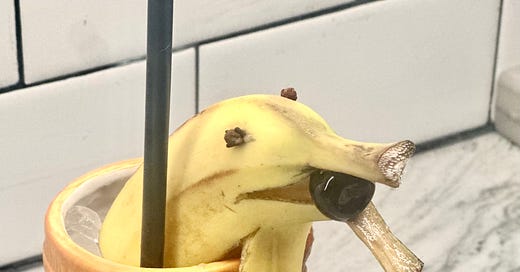A Theory of Cocktail Garnishes
Which ones matter, which ones don’t — and why banana dolphins are the greatest of all drink decorations.
For the longest time, I was a garnish skeptic.
I assumed that the assorted fruits, vegetables, and tchotchkes that topped so many cocktails were entirely decorative and thus irrelevant to the drink at hand. How much could a strip of orange peel matter, I figured? Is that brandied cherry really part of the drink — or is it just a tiny, sweet snack included in the package?
Cocktails, I believed, were strictly liquid concoctions, and while I didn’t exactly object to a neatly staged garnish, it also didn’t seem necessary, especially when making drinks at home.
Over the years, I came around to a more nuanced view. It’s true that some garnishes are simply decorative and thus mostly irrelevant (although there’s a time and place for irrelevant garnishes). But many garnishes add critical elements to the drinks they adorn.
Garnishes are not always entirely necessary to the construction of a drink; there are relatively few cases in which leaving out the garnish will cause a cocktail to fail entirely. Yet even less-than-essential garnishes can play an important role in either the taste, smell, or overall perception of a drink.
The way I think about it is this: Garnish frames a cocktail.
To understand what a frame does, consider the Mona Lisa. It’s a pretty good painting, or so I have heard. If you found it rolled up and slightly dusty in a thrift store somewhere, it would still be a pretty good painting. But one’s experience of the Mona Lisa is not just the painting itself. It’s the journey to the Louvre, the particular placement on the wall — and the choice of frame. All of these elements provide context and sensory information.
The frame is not the painting. But it does shape one’s experience of the work of art. With a different frame, a different wall, a different wall — or even no frame at all — the Mona Lisa would still be the Mona Lisa. But you’d experience it differently.
That’s what a garnish does for a cocktail. Think of an Old Fashioned with a fat strip of orange peel twisted over the top and dropped into the drink.
It’s not just that the drink is more visually appealing thanks to the pop of bright orange color — though it is, and that added visual appeal readies you for what’s to come.
It’s also that, as you bring the drink close for a sip, your nose picks up on the aromas from the oils released by twisting the citrus peel over the liquid. The garnish isn’t the drink. You could have an Old Fashioned without any orange peel at all. But the garnish shapes your experience — how it looks and how it smells. It has framed the drink.
Different garnishes, however, work in different ways, and some are more important than others. And the use-cases for garnish are somewhat different when making drinks at home versus at a bar.
So today, we’re going to look at how garnishes work, which ones matter most for home bartenders, and which don’t matter much at all. We’ll start by categorizing different types of garnishes and ranking them in terms of usefulness, and then we’ll go over some tips and guidelines for using garnish in your own drinks at home. Inevitably, we’ll talk about cocktails on Instagram.
And then, because I care about you, dear readers, we’ll end with a tribute to the greatest of all cocktail garnishes, even though it breaks all the rules: the banana dolphin.



